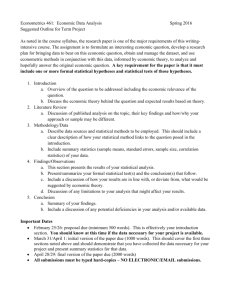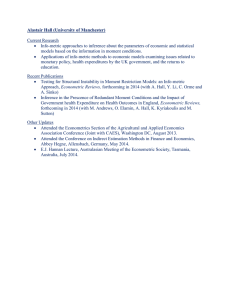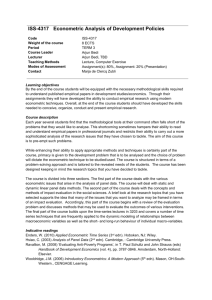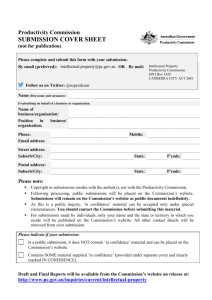Suggested best practice for submissions of technical economic analysis from CC2com3
advertisement
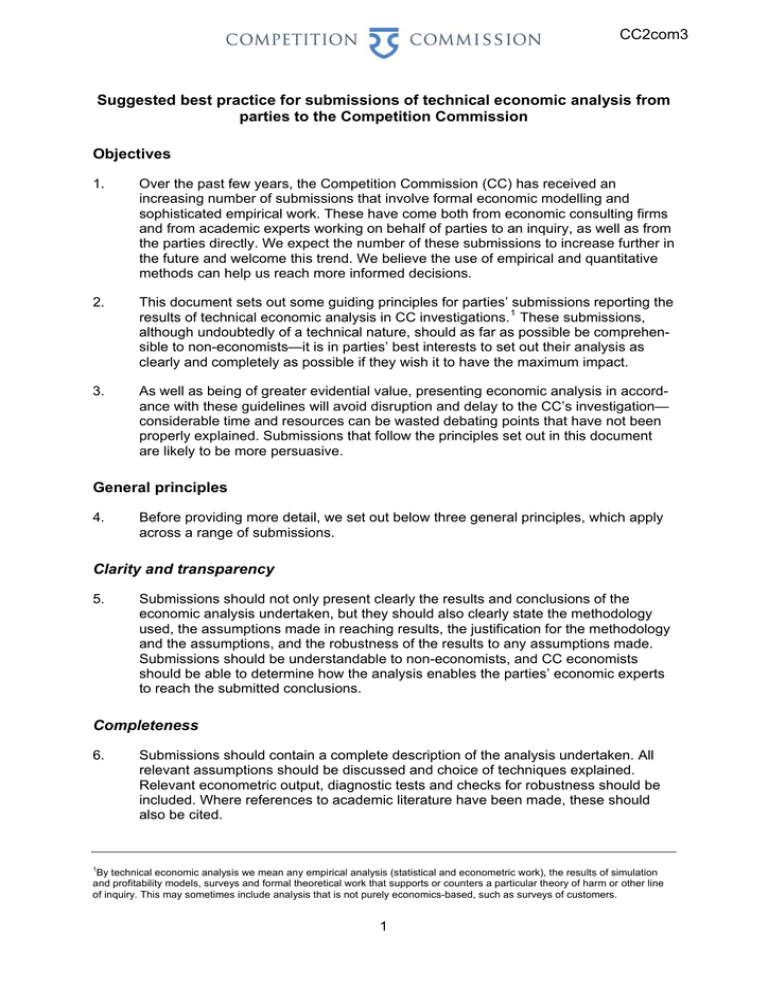
CC2com3 Suggested best practice for submissions of technical economic analysis from parties to the Competition Commission Objectives 1. Over the past few years, the Competition Commission (CC) has received an increasing number of submissions that involve formal economic modelling and sophisticated empirical work. These have come both from economic consulting firms and from academic experts working on behalf of parties to an inquiry, as well as from the parties directly. We expect the number of these submissions to increase further in the future and welcome this trend. We believe the use of empirical and quantitative methods can help us reach more informed decisions. 2. This document sets out some guiding principles for parties’ submissions reporting the results of technical economic analysis in CC investigations. 1 These submissions, although undoubtedly of a technical nature, should as far as possible be comprehensible to non-economists—it is in parties’ best interests to set out their analysis as clearly and completely as possible if they wish it to have the maximum impact. 3. As well as being of greater evidential value, presenting economic analysis in accordance with these guidelines will avoid disruption and delay to the CC’s investigation— considerable time and resources can be wasted debating points that have not been properly explained. Submissions that follow the principles set out in this document are likely to be more persuasive. General principles 4. Before providing more detail, we set out below three general principles, which apply across a range of submissions. Clarity and transparency 5. Submissions should not only present clearly the results and conclusions of the economic analysis undertaken, but they should also clearly state the methodology used, the assumptions made in reaching results, the justification for the methodology and the assumptions, and the robustness of the results to any assumptions made. Submissions should be understandable to non-economists, and CC economists should be able to determine how the analysis enables the parties’ economic experts to reach the submitted conclusions. Completeness 6. Submissions should contain a complete description of the analysis undertaken. All relevant assumptions should be discussed and choice of techniques explained. Relevant econometric output, diagnostic tests and checks for robustness should be included. Where references to academic literature have been made, these should also be cited. 1 By technical economic analysis we mean any empirical analysis (statistical and econometric work), the results of simulation and profitability models, surveys and formal theoretical work that supports or counters a particular theory of harm or other line of inquiry. This may sometimes include analysis that is not purely economics-based, such as surveys of customers. 1 7. The CC should be able to understand fully both the results and the economic theory and modelling that are generating those results, without having to seek more information from the submitting party. Replication of results 8. In a number of cases, the CC will want to replicate the results of the analysis that has been submitted. This means that parties should be prepared to respond to a CC request, at very short notice, for all relevant computer code and data files necessary for the CC’s economists to reproduce the results presented in the parties’ submission. This will include the raw and the cleaned data and the programs for obtaining the latter from the former. Detailed guidance on written submissions 9. The following section contains more detailed advice on a range of issues that might be covered in a submission. Structure of submissions 10. When presenting technical analysis, any submission should contain: (a) First, an executive summary of no more than five pages, which is accessible to non-economists and covers the purpose of the analysis, the nature of the data used, the methodology employed, the assumptions made, the results obtained and the robustness of the technical work. (b) Secondly, an overview that might also include, for example, further reference to economic theory, literature, methodology and explanations of how common econometric problems have been solved (eg endogeneity), how the model is identified and the choice of instrumental variables. (c) Finally, a technical appendix presenting the methodology and results in much greater detail, including any algebraic manipulation of models, econometric output and diagnostic tests as appropriate. 11. The summaries and the technical appendix should always be totally consistent. Data analysis and econometric estimation 12. When submitting the results of empirical analysis that relies on data, parties should take particular care to explain how any economic concerns have been addressed, and to ensure that relevant diagnostic robustness tests have been reported. Econometric modelling 13. The submission should contain a clear explanation of any economic modelling that underpins the empirical analysis. Although formal economic modelling is not required in every case, econometric analysis is often based on important assumptions. The CC should be able to understand any assumptions that parties have made in setting up their analysis, so that it can assess the reasonableness of those assumptions and test them against all the evidence it has received in the case. 2 14. A list of references, including relevant articles that use a similar methodology, should also be included. These should include articles by academics and practitioners. 15. The submission should always contain a clear explanation of the rationale for the choice of methodology used to analyse the data. In doing this, any technical concerns should be addressed. By way of example, some particular concerns that might arise, and should be tackled, include: (a) The economic concept of ‘identification’—that is to explain if and how the model can identify the economic impacts that are being measured, separated from other factors and events. For example, an analysis of spending on a product before and after some event should be able to identify the impact of that event, separated from other factors that may have changed at the same time; or, when comparing levels of prices in different geographic areas, it should be able to identify whether this is due to the factor being considered, or some other factor that is often correlated with it. (b) The choice of ‘instrumental variables’. Sometimes, it may be preferable to use an alternative ’instrument’ to substitute for the actual variable of interest, as a solution to certain econometric problems. However, in these cases, parties should explain why particular instruments have been chosen and consider the robustness of such choices. (c) A common econometric method involves the estimation of reduced-form equations (eg reduced-form price equations), as opposed to structural equations that are directly derived from a formal economic model. However, the specifications of a reduced-form equation are best understood with an understanding of the underlying structural parameters. It will sometimes be difficult but, where possible, submissions relying on this type of modelling approach should provide the motivation for the econometric specification of a reduced-form equation. (d) Omitted variables can be a common source of bias in econometric models. Where relevant and possible, submissions should include a consideration of what omitted variables there might be and the possible consequences their omission could have for the matter at hand. 16. This is by no means a comprehensive list and a similarly thorough approach should also be taken with any other econometric issues as they arise. Presenting results 17. When presenting the results of statistical and econometric modelling in written submissions, parties should always include the appropriate diagnostic test results (t-statistics, R2, etc). Unless the CC is able to understand both the statistical and economic significance of the reported results it will not be able properly to evaluate the importance of modelling output and the results will be less influential. Accordingly, the economic significance of results should also be explained, especially when this is not clear from the econometric output. Testing robustness 18. It is good practice to test the robustness of econometric analysis—in other words, to test whether the results are sensitive to plausible changes in the assumptions. The CC may want to carry out its own tests, but would expect evidence of the robustness of a piece of analysis to be provided by the parties. 3 Underlying data and files 19. As mentioned in the general principles above, parties should be prepared to submit data and files at very short notice, to enable the CC to replicate any analysis. The code should be clear, with a description provided such that it is easy to match it with the reported results. Providing data 20. ‘Raw’ data should be provided wherever possible. For example, if a piece of analysis is based on daily transaction price data but only uses monthly average prices, the CC will require access to the daily data. Because the aggregation and cleaning of data may have a significant impact on the outcome of statistical or econometric analysis, it is important that the CC has access to the underlying data. 21. Parties should also make clear how raw data has been compiled and what steps have been taken to ensure its reliability. For instance, if the raw data is based on a sample of individual customer accounts, an explanation of how these accounts have been chosen and why they are representative of all customers should also be provided. Providing program files 22. Parties should provide the program files that manipulate and clean the raw data in preparation for the analysis. Analysis often relies on data that has been ‘cleaned’— for a variety of reasons one may want to discard some observations, either because they are considered as outliers, or because there is a reporting error. Although data cleaning is perfectly legitimate, the CC will want to see for itself how this process has been performed in any given case. Parties should provide a precise description of the data-cleaning process, preferably provided as annotated computer code, and specifying the nature and number of data records eliminated or changed at each step. 23. The files generating the econometric and statistical analyses should also be provided to the CC. Again, clear and complete comments should be included along with the code in the program files. 24. Using procedures in statistical packages tends to provide a better audit trail than using spreadsheets, so we encourage their use where possible. Although we do not mind receiving spreadsheet analysis, it can be more difficult to unpick the procedures from the data. Survey evidence 25. Parties sometimes submit evidence which relies on surveys—for example, the percentages of customers who hold particular opinions. When the CC is to rely on survey evidence prepared or commissioned by the parties, as well as needing to see the precise questions that have been asked, it will also require additional supporting information and submissions should include the following: Description of the research process • A short statement of the purpose of the survey and the brief given to the research team, describing the members of the team that managed the research, including 4 their roles in the team and their affiliations, and the timeline of the research project, including fieldwork. Description of the sample and research process • A short description of the sampling design and research methodology, which should cover: (i) How respondents were selected and approached, including which quotas were used and how they were determined and implemented, the locations and timing of fieldwork and the rationale for such choices. (ii) The methods used to collect data and the rationale, if any, for these methods. (iii) A short description of the final sample that was achieved, including counts of the numbers not responding or excluded by category, and a comparison of the characteristics of the sample with those of the population from which the sample was drawn (eg age, social grade). (iv) Research input materials, including the question script containing the questions with any pre-coded responses, code-frames used to categorize verbatim answers, and supplementary instructions or materials given to respondents, fieldworkers or interviewers where these are not obvious from the question script. Description of output • 26. Research output materials, including any original presentation files or reports arising from the research; any tables of results used either to generate the presentation files or reports; and any tables of results otherwise being used by the party as evidence. Where tables or charts report weighed results, parties should provide counts of unweighted responses and detail of weights used. In addition, where the CC believes that the survey may contain further evidence that would be of value to its inquiry, the CC may require the party to submit further information from the survey. In doing so, the CC will wish to respect the professional code of the Market Research Society regarding any assurances provided to respondents (such as assurances of confidentiality or anonymity at the time of interview). Formal economic modelling 27. The submission of formal economic models is welcomed, as it can formalize the logic of economic arguments in a rigorous manner. Identifying key assumptions 28. All economic models make assumptions for convenience and tractability. The submission should present all assumptions clearly, and discuss the reasons for making each in turn. As for the empirical modelling discussed above, it is important that the CC is able to test any assumptions that parties have made against all the evidence it has received in the case. 5 Algebraic manipulations and proof 29. All key results should be clearly derived, setting out the relevant algebraic manipulations and proofs. Sensitivity analysis 30. Because a formal economic model is based on a set of assumptions, a discussion of the robustness of the results is warranted. For example, the submission should make clear whether the results would hold generally when a specific functional form is adopted. Alternatively, assuming a particular market structure might have some impact on the final results. 31. It would also be helpful to provide a numerical simulation to see how the results vary with different parameter values. Relevant economic literature 32. The submission should also contain references to the relevant economic literature. Simulation models 33. Simulation models are based on formal, structural economic models. Therefore, the same requirements also apply for this type of submission. 34. The parties should provide all program files that generated the simulation results. Models of economic profitability 35. Models of economic profitability are welcome because they can be useful in helping to understand the deficiencies in profit calculations based purely on accounting data. Parties should bear in mind that such models will normally be scrutinized within the CC by Chartered Accountants, rather than economists, however the general principles set out earlier in this document apply equally to these models as to other economic models. 36. The following specific points should be borne in mind when submitting material of this type: (a) Explanatory notes should be provided, including a clear explanation of the approach taken to the modelling and why this is to be preferred over other approaches; a clear explanation of how the spreadsheet model has been constructed, including the use of any macros; and an explanation of the sources of data used as inputs to the model. All assumptions should be clearly listed and the derivation of these assumptions should be fully explained. (b) An explanation of how input data can be traced back to, or reconciled to, audited financial data should be provided. Where this is not possible, it is important to explain the reasons for this. Consideration will also be given to whether the input data and assumptions are used by the business in reviewing its financial performance. (c) The full spreadsheet model should be submitted, including integral formulae, to enable the model to be replicated by the CC. 6
